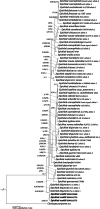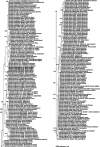Epichloë scottii sp. nov., a new endophyte isolated from Melica uniflora is the missing ancestor of Epichloë disjuncta
- PMID: 35109929
- PMCID: PMC8812020
- DOI: 10.1186/s43008-022-00088-0
Epichloë scottii sp. nov., a new endophyte isolated from Melica uniflora is the missing ancestor of Epichloë disjuncta
Abstract
Here we describe a new, haploid and stroma forming species within the genus Epichloë, as Epichloë scottii sp. nov. The fungus was isolated from Melica uniflora growing in Bad Harzburg, Germany. Phylogenetic reconstruction using a combined dataset of the tubB and tefA genes strongly support that E. scottii is a distinct species and the so far unknown ancestor species of the hybrid E. disjuncta. A distribution analysis showed a high infection rate in close vicinity of the initial sampling site and only two more spots with low infection rates. Genetic variations in key genes required for alkaloid production suggested that E. scottii sp. nov. might not be capable of producing any of the major alkaloids including ergot alkaloid, loline, indole-diterpene and peramine. All isolates and individuals found in the distribution analysis were identified as mating-type B explaining the lack of mature stromata during this study. We further release a telomere-to-telomere de novo assembly of all seven chromosomes and the mitogenome of E. scottii sp. nov.
Keywords: Alkaloid profile; BUSCO multigene-phylogeny; Epichloë; Melica uniflora; New species; Oxford nanopore; Telomere-to-telomere de novo genome assembly.
© 2022. The Author(s).
Conflict of interest statement
The authors declare that they have no competing interests.
Figures








References
-
- Ashrafi S, Helaly S, Schroers H-J, Stadler M, Richert-Poeggeler KR, Dababat AA, Maier W. Ijuhya vitellina sp. Nov., a novel source for chaetoglobosin A, is a destructive parasite of the cereal cyst nematode Heterodera filipjevi. PLoS ONE. 2017;12(7):e0180032. doi: 10.1371/journal.pone.0180032. - DOI - PMC - PubMed
-
- Becker M, Becker Y, Green K, Scott B. The endophytic symbiont Epichloë festucae establishes an epiphyllous net on the surface of Lolium perenne leaves by development of an expressorium, an appressorium-like leaf exit structure. New Phytol. 2016;211(1):240–254. doi: 10.1111/nph.13931. - DOI - PMC - PubMed
-
- Berry D, Lee K, Winter D, Mace W, Becker Y, Nagabhyru P et al (2021) Cross-species transcriptomics comparing the benign asexual and antagonistic pre-sexual developmental stages of grass-endophytic Epichloë fungi. Under review
-
- Bultman TL, Leuchtmann A. A test of host specialization by insect vectors as a mechanism for reproductive isolation among entomophilous fungal species. Oikos. 2003;103(3):681–687. doi: 10.1034/j.1600-0706.2003.12631.x. - DOI
LinkOut - more resources
Full Text Sources
Other Literature Sources
Research Materials
